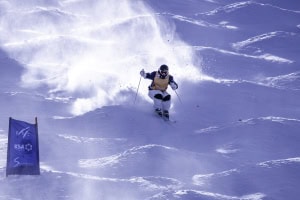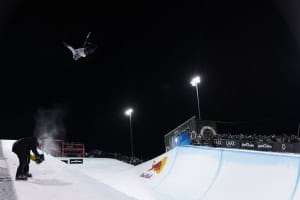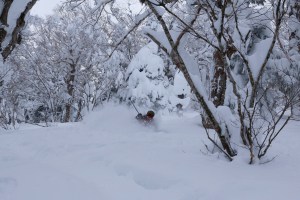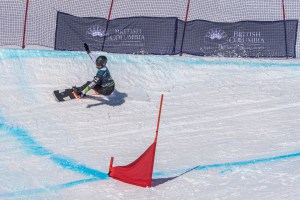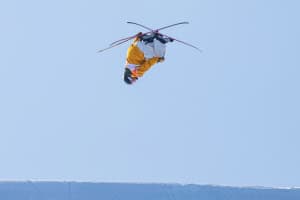Highs and Lows from Behind the Scenes at PyeongChang
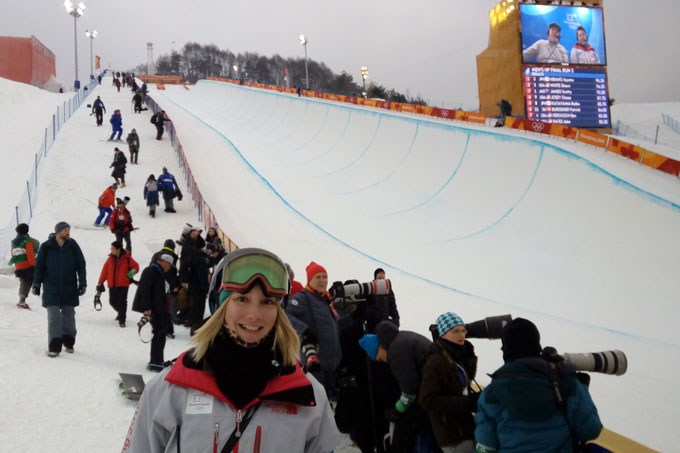
Alex Parsons, as close as you get for the snowboard finals.
Mountainwatch | Alex Parsons
Did you watch the Winter Olympics? Of course, you did. I’m sure you’ve been thinking how awe-inspiring, how polished and impressive it all looks. And it is. TV really works its magic for the Olympics.
But behind the scenes – let me tell you – it’s chaotic.
Among all that chaos you may be surprised to learn that there are ten Australian staff from Thredbo helping to smooth things out. We work in all the behind-the-scenes roles that never get any attention, but ensure the Olympics look as shiny as ever.
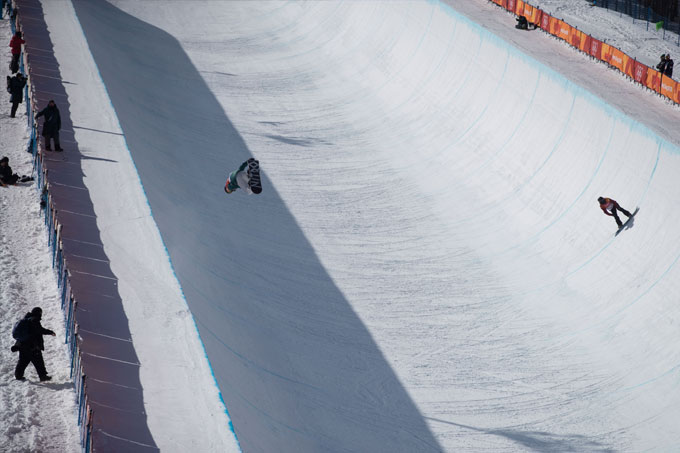
One of the benefits at working at Phoenix Park was seeing the events live and also being on hand for training sessions. Nate Johnstone, putting on a show for course workers during halfpipe practise. Photo: Boen Ferguson
How did we get the job?
Back in the winter of 2015/16 I worked as a snowboard instructor at Phoenix Park in Pyeongchang, the location for all the freestyle skiing and snowboarding events, other than the Big Air. I decided to come back for the 2017/18 season with the promise of transitioning into the Olympics after the resort closed, and brought a whole host of Thredbo instructor friends with me.
What have we been doing?
Phoenix Park officially closed for business as a snow resort on January 21. Since then we’ve been crowned “National Technical Officials”, helping to build and maintain most of the courses.
The majority of the team (Ruth, Jack, Olivia, Tommy and Chris) have been creating the moguls course, then moved to the aerials jumps and are finishing up with the parallel giant slalom course. But we’ve been jacks of all trades and have also been sent to help out on the skicross/boardercross and slopestyle courses.
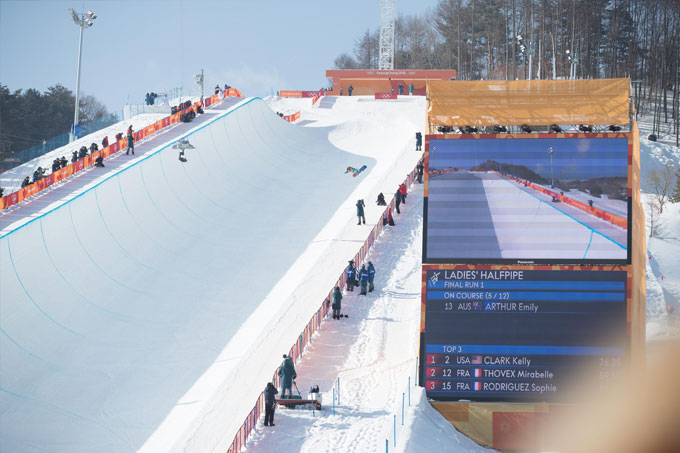
One of the highlights for Alex was watching you Australian Emily Arthur making it through to the finals at her first Olympics. Photo: Boen Ferguson
Recently Scott, Lana and myself have been in charge of setting up and scheduling the training courses. Mark and Josh were gifted the task of helping to build an Olympic halfpipe and then slipping before, during and after events.
If you were watching the halfpipe events and saw a bunch of skiers and boarders in pink side-slipping down the course in a V formation – that was them.
What did we get out of it?
“Strong legs and nosebleed section seats to the greatest halfpipe battle ever!” Josh jokes.
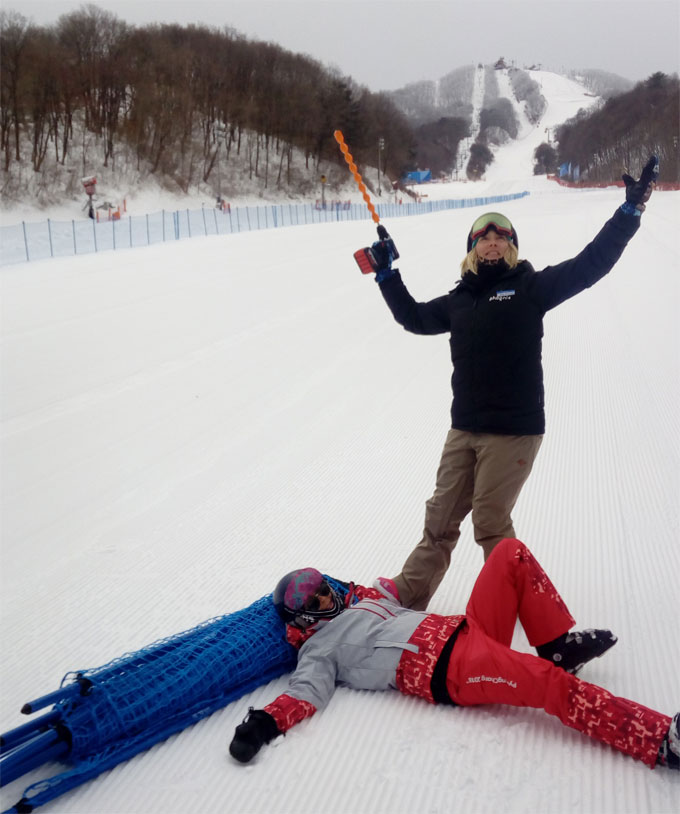
Fun and games at the games
Unlike most of the workers in pink uniforms, we’re not volunteers and we do get paid. That’s just as well because, as Mark says, “I’d only do this in a paid position. Some of the bullshit we had to go through was not worth volunteering for.”
On top of that we’ve received a whole bunch of North Face gear to wear, including boots, gloves, glove liners, a beanie, thermal top, mid-layer jacket and hideously coloured snow jacket and pants. We get to keep it all and have also picked up a few free gifts along the way, including the Pyeongchang 2018 mascot toys, pins, a scarf from the Korean president, swanky raincoats and way too many instant noodles.
The best bits
The experience itself and getting to be up close to our sporting heroes has been the main thing our Aussies have raved about.
“The best thing is we’ve gotten to watch pretty much all of the events happen live from the sides of the course, which was mind blowing,” says Scott, a skier who usually works for the Race Department in Thredbo.
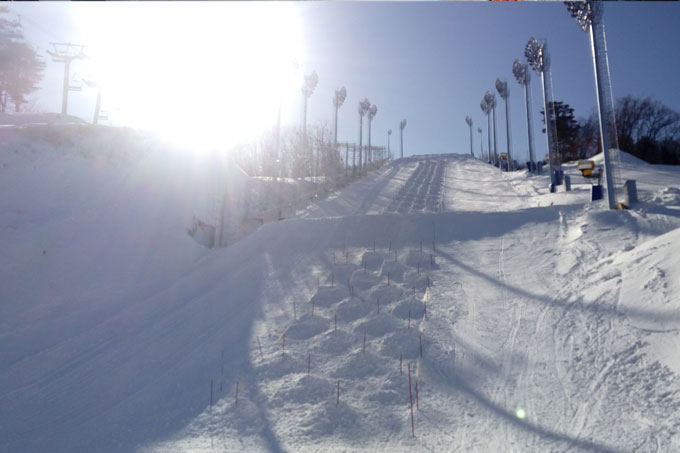
Building the mogul course is not an easy task. A shot from the early stages of the course where Matt Graham won his silver medal.
Indeed, a bunch of us were right at the bottom of the halfpipe, closer than anyone else, during the epic battle between Scotty James, Ayumu Hirano and Shaun White. I was also proud to be there when Chloe Kim became the first woman to put down back-to-back 1080s in an Olympics, and to see our own Emily Arthur make it to finals in her Olympic debut.
Our local team has also had access to ride each of the courses after the events have finished. Ruth, who worked predominantly with the moguls and aerials crew, explains: “The best part has been watching my colleagues ride these courses before and after the event and absolutely froth on it. That’s why we’re in this business really. Plus, how cool is it to say that you’ve ridden a slope at the Winter Olympics?”
The worst bits
Have you heard the stories of thousands of Olympic volunteers quitting? It’s been alleged that hundreds of volunteers have left their posts due to the extreme cold, substandard accommodation, poor meals and lack of transport. And while we may not be volunteers, a lot of their complaints have rung true for us.
“There’s not enough food,” says Mark. “We’re eating two minute noodles six times a day.”
Scott concurs: “The worst thing is probably the constant security checks and the fact we had very limited access to a number of checkpoints, which made it difficult to get food. It’s tricky living on instant ramen and juice poppers.”
Furthermore, there has been a lot of waste for what was meant to be a “green games”. We could only drink bottled water every day because we were warned off the tap water and our reusable water bottles frequently cause problems with security. “The amount of waste the Olympics produces is astonishing,” said Ruth.
As ski and snowboard instructors, we may be used to the cold (or at least know how to layer appropriately for it) but the hours were tough. The halfpipe crew would often need to be on the hill, ready to go, at 5am. They frequently worked 11 and 12 hour days.
The most surprising aspects
Honestly, we weren’t expecting to be so hands on with the courses. We literally built the moguls up, shoveling them and shaping them for days. Then we had days of slipping between each mogul and chopping up the landings of the jumps.
Our team also played an integral role in constructing the massive aerials jumps. Scott explains, “I was pretty surprised at the fact that we got to build the framework for the aerials jumps for sure. I would never have expected to have a hand in that, but I’m glad that we did.”
The very size of the courses has really impressed us too. “They’re much bigger than what the TV shows,” said Josh.
“I have a new appreciation for how big the athletes go,” adds Mark. “It’s all way bigger first hand, the TV makes it look super small.”
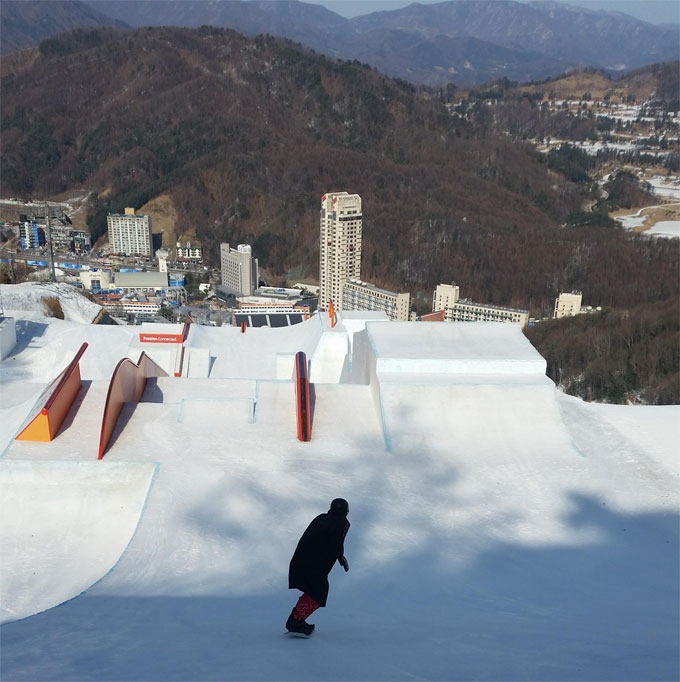
How good this? Getting to road test the slopestyle park before the main event.
The biggest disappointments
Personally, I was really disappointed that the Women’s Slopestyle Finals went ahead in such horrendous weather. I was on the ground that day and the wind was absolutely howling, there was about -28 wind-chill and the course looked bulletproof. It simply should not have gone ahead. But it did.
It made me realise that the Olympics is just like any other business that prizes profits over people – even if those people are the world’s best athletes.
The poor safety standards during the construction of the courses has also been a major let down. We frequently didn’t feel safe and a lot of people got hurt, including myself.
Mark reiterates this, “A big disappointment is how people are treated. Both volunteers and paid staff – especially paid staff. When things go wrong or people get hurt it takes too long to get help and be treated. Then they just get kicked out.”
Perhaps this was in part due to the poor organisation behind the scenes. Many of the paid staff were under qualified for the jobs. Some of the people specifically employed to be side-slippers had barely skied before. Few of the Korean staff spoke English, which led to many misinterpretations and delays.
Mark explains, “I expected them to have a team that was prepared, had done their research and could just roll in and know what to do. There just wasn’t. All the leaders were running around with their heads cut off.”
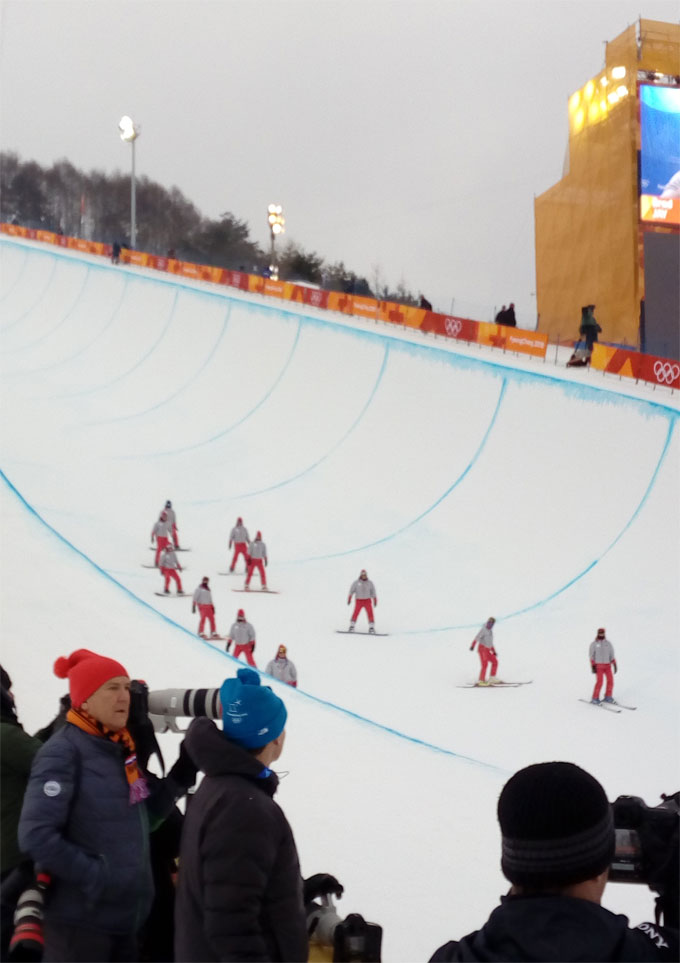
A troupe of side slippers in between pipe runs.
The absolute highlights
Being up close and personal to the events and our favourite athletes has been everyone’s highlight.
“I think the highlight for me was getting to see Scotty James, Matt Graham and Jarryd Hughes all podium for the green and gold right in front of me,” says Scott.
As for myself, I high fived and congratulated Maddie Mastro on making it to the halfpipe finals, I gave Chloe Kim and Arielle Gold some snacks, I had some great chats with boardercross silver medalist Jarryd Hughes. And I walked past Scotty James a whole bunch of times, but was too nervous to say anything.
Each of these moments are burned into my brain and are sure to be told and retold to my friends and family.
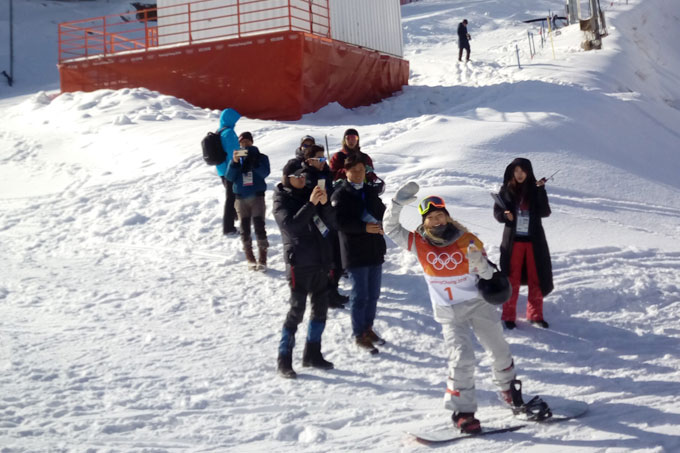
“Hi Cloe. Well done on your win.”.
Would we do it again?
Although there were certainly days that we wanted to quit, the whole team has a similar sentiment when it comes to this question.
Scott sums it up nicely, “I would 100% work at another Olympic Games. It’s been cold, stressful, tiring and frustrating at times. But it’s been an unforgettable experience and I wouldn’t trade it for the world.”


